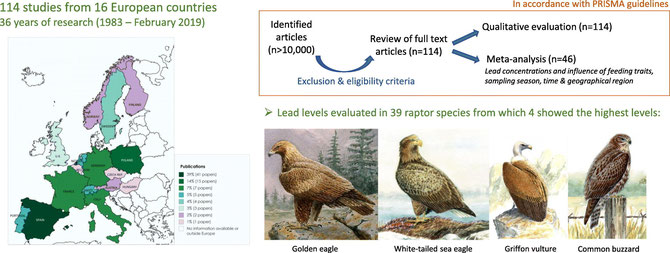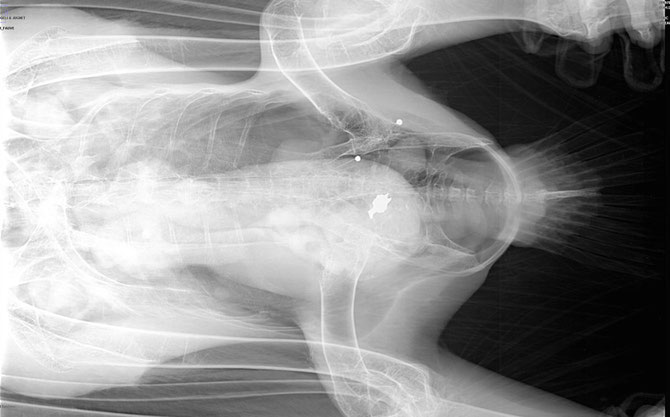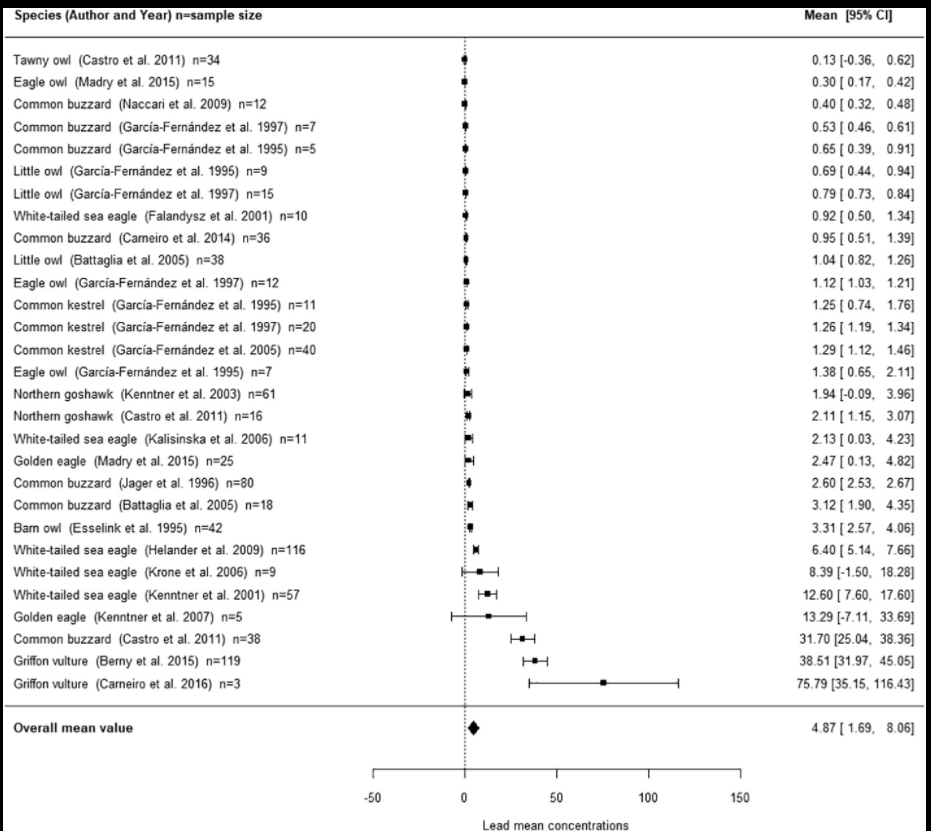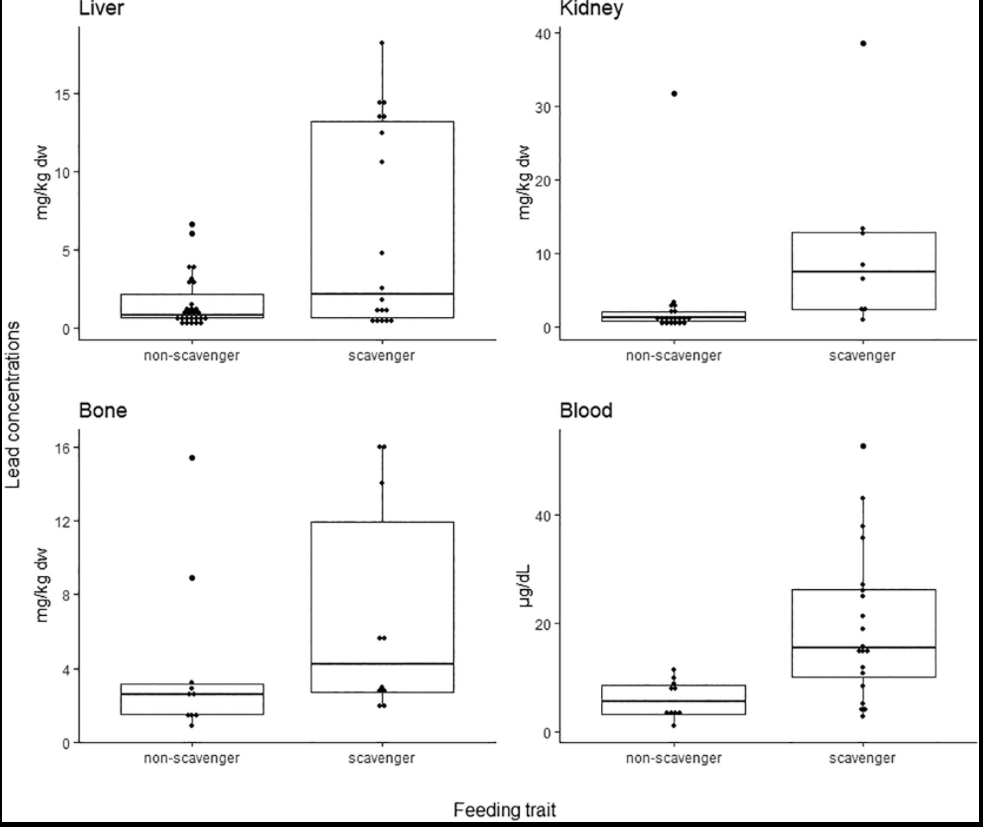
A meta-analysis of published research from across Europe has demonstrated that obligate (vultures) and facultative scavengers (golden eagle, common buzzard and white-tailed sea eagle) have the highest lead concentrations in sampled body tissues and are the most likely species to experience lead poisoning, confirming it is a widespread threat.
Overview
Lead contamination poses a severe threat to birds of prey, including vultures. Although various studies assessed the impact of lead on individual raptor species, the published data have not been systematically evaluated to understand raptor-wide lead exposure and effects at a pan-European scale, until recently. To critically assess the extent of this problem, the research team performed a systematic review of all published data on lead exposure in raptors between 1983 and 2019. Via this meta-analysis, the researchers determined whether there was evidence for differences in exposure across feeding traits (e.g. scavenging versus non-scavenging), geographical regions, between hunting and non-hunting periods, and changes over time as well as the impact of lead on raptors and the likely primary sources of exposure.
Method
The research team reviewed 114 relevant studies published during different periods (1983-2019) and performed in various countries. The team conducted a quantitative meta-analysis according to the Preferred Reporting Items for Systematic Reviews and Meta-Analyses (PRISMA). They only included publications containing data that reported raw or statistical summary data on lead concentrations in raptors.
Results
Lead concentrations in samples
Peer-reviewed articles reported data for 39 species were studied, consisting of 29 birds of prey (four obligate scavengers, five facultative scavengers and 20 non-scavengers) and ten owls. The most studied species amongst the birds of prey were the Common Buzzard (Buteo buteo; 23 papers), the White-tailed Sea Eagle (Haliaeetus albicilla; 20 papers) and the Griffon Vulture (Gyps fulvus; 15 papers).
The Griffon Vulture, an obligate scavenger, had the highest lead concentrations in liver and kidney on average, followed by facultative scavengers (common buzzard, golden and white-tailed sea eagle). A single study showed that the Marsh Harrier (Circus aeruginosus) had the highest blood lead levels, but on a general level, the Griffon Vulture had the highest. The Golden Eagle (Aquila chrysaetos), the Eurasian Eagle Owl and the Common Buzzard were the species with the highest levels of bone lead.
Blood lead concentrations were higher in birds sampled during hunting seasons, providing evidence that lead hunting ammunition could be a primary source of lead exposure. Analysis determined that geographic region did not indicate any significant difference between regions for lead concentrations in liver. Overall, there was no consistent temporal trend across decades in average lead concentrations in kidney and blood, but there was a marginally significant decrease between 2000-2009 and 2010-2019 in liver lead.
Effects of elevated lead and associated sources
Subclinical effects
Over half of the species studied reported lead concentrations that exceeded subclinical threshold values. The Bearded Vulture (Gypaetus barbatus), the Griffon Vulture, the Red Kite (Milvus milvus) had the highest prevalence of exceedances. The primary source and route of exposure was ingestion of lead ammunition (31 studies), followed by lead shot (9), lead fragments (5) in the gastrointestinal tract of birds and lead in regurgitated pellets (4). Another source of lead exposure (12 studies) was mining and urban/industrial pollution.
Lethality
A total of 36 studies, encompassing 14 species, reported lead residues that exceeded the concentration thresholds for lethal lead contamination and lead-induced mortalities, mostly during the last two decades. The highest proportions were for the Bearded Vulture, followed by the Red Kite, White-tailed Sea Eagle, Golden Eagle and Common Buzzard.
In summary, the key points determined through meta-analysis include:
- Scavengers, both obligate and facultative species, are more prone to lead contamination than non-scavengers, including birds of prey and owls.
- Lead contamination in raptors is still widely detected across Europe despite partial bans on the use of lead in ammunition and shot.
- During the hunting season in southern European countries there is a seasonal peak in blood lead concentrations
- The levels of exposure in several species like the Bearded Vulture are generally relatively high and exceeding the subclinical threshold levels is widespread.
Overall, the research demonstrates the high incidence and ubiquity of lead contamination among raptors in Europe. However, the research team did not find studies that related exposure to quantitative effects on European raptor populations or comprehensive studies on the impact of mitigation measures. This type of information is urgently required in a more harmonised approach to quantify lead contamination and effects in raptors across Europe.
The authors, therefore, provided the following recommendations for researchers and conservation practitioners:
- “Monitoring the same species across different monitoring schemes and countries. Suitable candidate species have been suggested elsewhere(Badry et al., 2020). In agreement, we suggest the common buzzard and the golden/white-tailed sea eagle combination as potential species to monitor lead trends in Europe. Our review indicates these species are more prone to lead poisoning and are also most widely monitored across Europe. Their distribution is also suitable covering most of Europe.
- Monitoring the same sample matrices across schemes. This review shows that lead levels in kidney and liver are highly correlated and these matrices could be used interchangeably to some extent, al-though this would require further studies to generate species-specific read-across values. Monitoring of lead using non-invasive samples, such as feathers, has the potential to increase our breadth of knowledge about exposure of raptors to lead but further studies are required to determine adverse-effects threshold values.
- This review shows that there is a scarcity, and in some cases complete absence, of data on lead exposure and monitoring in the northern and eastern Europe, and increased sampling and measurements are recommended for these regions.
- As hunting ammunition is among the most important causes of lead poisoning in raptors, publications should always specify when samples are collected (winter, breeding, hunting, non-hunting season).
- Lead-based ammunition is a well-recognised source of lead exposure and poisoning in raptors, yet it is difficult to confirm. More routine measurement of tissue isotopic signatures, searching for ammunition fragments in the gut, and non-invasive monitoring of regurgitated pellets would all enable quantification of the true scale of exposure.Where possible, we recommend analysis of lead isotopic ratios as well as determination of total lead concentrations.
- When reporting results, studies need to publish the data for individuals, either as part of the supporting information of the paper or preferentially as published datasets that can be downloaded from data archives. Metadata should include information of the quality assurance measurements associated with the lead concentration data. Provision of such information, and inclusion within publications of the full range of summary statistics (mean, median, variance and range of values) would enhance data comparability and the value of such studies for future systematic evaluations.
- When mortality or subclinical effects are reported, it is crucial to provide individual information on the tissue lead levels that are related to the effects.
- This review shows that there are few studies on the subclinical effects of lead in raptors and the consequences and significance of subclinical exposure remains largely unknown. We highlight the need for such studies which should focus on subclinical effects that may directly or indirectly affect survival and reproduction.”
Source
L. Monclús, R.F. Shore and O. Krone, Lead contamination in raptors in Europe: A systematic review and meta-analysis, Science of the Total Environment (2020), https://doi.org/10.1016/j.scitotenv.2020.141437
Protecting vultures from lead poisoning in Europe

In recognition of the impacts of lead poisoning or contamination, we here at the Vulture Conservation Foundation are committed to working towards a gradual and consensual elimination of lead ammunition from vulture habitats. We are working with other conservation organisations, hunters and governments towards passing laws and regulations to minimise this threat.
Lead poisoning was recognised as an important threat to vultures in the Vulture Multi-species Action Plan (Vulture MsAP), a global plan for the conservation of 15 species of vultures, co-developed by the VCF, and endorsed by the Convention for Migratory Species, which called for the phasing out of its use.
Across Europe, we have been involved in several initiatives to reduce the use of lead ammunition. We are supporting pilot projects by promoting lead-free hunting practices and facilitating the use of non-lead ammunition with hundreds of hunters across several important vulture regions like the Alps, Pyrenees, Massif Central, Cres Island and Rhodopes Mountains, within the framework of several LIFE and MAVA funded projects. As part of our anti-poisoning efforts across the Mediterranean, we will expand our work to address the threat of lead ammunition within the second phase of the MAVA project. We have also contributed to the ongoing European Chemicals Agency (ECHA) consultations about restricting the use of lead ammunition for hunting in wetlands and in terrestrial habitats (see document below).
Public consultation – lead terrestrial R
Adobe Acrobat Document 830.7 KB






